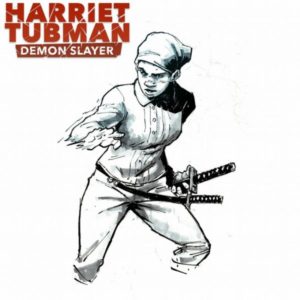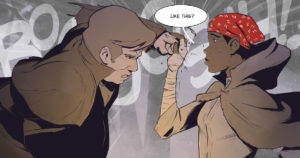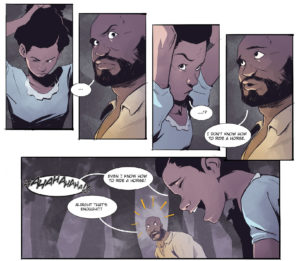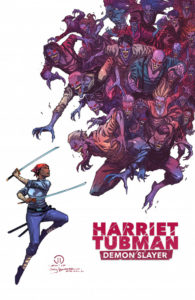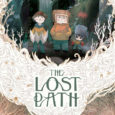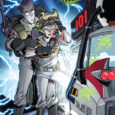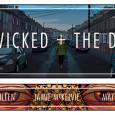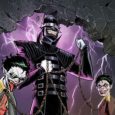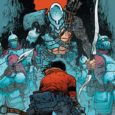For a few years back in the early 2010s horror mash up stories were all the rage. Take an innocuous but well known thing and mix it with a fantasy horror trope and a new hit was made. These were most evident through books like Pride and Prejudice and Zombies and Abraham Lincoln: Vampire Hunter and probably a few others not written by Seth Grahame-Smith. Though that genre has been dormant for a few years, it’s come back quite well with the recent release of Harriet Tubman: Demon Slayer.
Written by David Crownson, Harriet Tubman: Demon Slayer takes place (appropriately) in 1860, deep in the heart of America’s days of Slavery. It opens with a slave family, the Edgefields, as they escape their plantation in search of a life as free folk. When they run afoul of a trio of shady white men, the Edgefields stand their ground only to discover that these men aren’t exactly what they seem to be. Luckily, a mysterious stranger, the eponymous Harriet Tubman, shows up to save them.
One of the things I liked most about the book is the humor. Within the first couple of pages, Crownson makes a joke at the expense of one of his characters and it’s brilliant because it serves a higher purpose than a mere moment of levity. In addition to setting the tone for the book, that initial joke lets the audience know that despite the heady subject matter, they’re allowed to laugh at the story. This is a necessary cue for readers like me, a middle class white man, during the times that the N-word gets bandied around. That word would (rightfully so) make modern audiences uncomfortable but was necessary to tell a story that borrowed heavily from the time of slavery and Harriet Tubman’s real-life struggle. Crownson breaks the ice early to alleviate any possible squeamishness.
The art on the book is superb. Courtland Ellis’ art is smooth, his figures realistic and graceful. There are no overly muscular men rippling through torn shirts. His women aren’t bodaciously disproportioned, and in fact have noticeably different body types. Ellis uses subtle facial expressions on his characters to portray emotions and tip the readers off to what they’re thinking, but he’s then able to go all out during the funny moments. It can be a jarring juxtaposition at times but really ramps up the humor.
The art isn’t perfect, though. Most of the pages are beautiful, however, there’s some panel progression that feels off. Some of the character movement is choppy and stilted, which is detrimental in a book that relies heavily on fight scenes. Thankfully, it’s easy to overlook because there are so many other things to enjoy but hopefully it improves as the series progresses.
Ellis also shines in how he draws backgrounds, notably in the way he uses large brushstrokes to signify foliage. It’s drastically different from mainstream comics and I absolutely love it.
My biggest problem with the book is the dialogue. While most of the characters’ speech is smooth and energetic, the story is sprinkled with one-liners that just seem trite and unnecessary. It tended to be more good than bad, though.
I also wasn’t a fan of the localized dialect. This was probably included to show how different groups speak differently and was effective in establishing the world the story takes place in. I felt like it slowed down the reading experience, forcing me to puzzle out what the characters were saying. I understand that I’m splitting hairs here and maybe sound a little pedantic but this was definitely my take away from the reading experience.
Also, I need to point out the book’s poor punctuation. Normally I don’t even notice the lettering in comic books but the fact that this drew my attention means that it really stood out. Granted, some of the punctuation choices may have been stylistic but there are some instances that are just inconsistent, making the lettering come off as lazy or rushed. Again, I have hope that this will be remedied in future issues.
Despite its flaws, though, one thing that Crownson gets right is the mystery surrounding Harriet Tubman: Demon Slayer. His opening chapter focuses on establishing the characters. He doesn’t dive too far into why the vampires are chasing runaway slaves or even where Harriet comes from. We know nothing of her past, her upbringing, or how she knows how to fight. Crownson reveals just enough to whet my appetite but not too much that I lose interest and don’t return for the second issue.
Having purchased Harriet Tubman: Demon Slayer on a whim during Free Comic Book Day (it was funded through a successful Kickstarter), I have no idea how to get a physical copy of the book. However, you can buy it in digital on Comixology and Peep Game Comix. And I wholly recommend you pick it up. Not only is this book a fun read but it’s also an interesting take on the horror mash-up genre and the life of one of the most prolific American humanitarians.
Grade: B-
Marjorie Liu wastes no time in building a diverse world, one rich in lore, and rife with struggles that echo real life war torn lands. Thematically, this is a story of survival for Maika and any companions she picks up on her journey.
In an interview with TheNerdsofColor, Liu describes some of her inspiration:
For a long time, I’ve always been thinking about what does it take to survive a cataclysmic war? What does it take to put yourself back together again after surviving something that horrific?
If Maika is any indication, you don’t put yourself back together fully, as shown by the yet unexplained missing appendage of our beautiful, yet fierce protagonist.
There is a delightful contrast between the charming cherubic faces of the small hybrid creatures, like the fox girl, Kippa, and the gore-filled violence of Monstress. In a setting where those in power are women, Liu takes care to provide a distinct voice for each of them, showing the facets of their personalities. So far, some of these characters are the monsters.
The project’s massiveness took Liu by surprise, and she told The Hollywood Reporter:
“I wanted to write about girls and monsters, which has been a theme of mine from almost the start of my career — girls and giant monsters, and the supernatural. I wanted to tell a story about war, and surviving war — and I wanted to set it all in an alternate Asia.”
Monstress certainly fulfills those requirements and without falling into popular tropes. Maika is definitely not the Asian Other, an exotic male fantasy for the rescuing, nor is she another Strong Female Character on her way to being someone else’s love interest or sidekick; there’s more to her than what we see in this first issue, and it’ll be an exciting journey with Liu and Sana Takeda at the helm.
Sana Takeda’s art is reminiscent of Japanese illustrator Yoshitaka Amano fantasy work, but where Takeda shines is in her incredible detail. From the get-go, this comic was on my radar thanks to that eye-catching cover, and allow me to say that the interiors and colors are equally beautiful. Sana Takeda does every bit of artistry in this book, from cover to color, and her attention pays off in a big way. Earthy tones provide excellent juxtaposition to flashes of bright color due to magic, or rivers of gold from clothing or metalwork, helping to create the vivid, steampunk infused Eastern flavor that helps make Liu’s story work.
Takeda also proves adept at bringing Liu’s disabled Asian female character to life, whom at no point comes across as weak, even as her first appearance is naked, yet defiant, as she is sold at auction. Maika’s powers aren’t the only thing magical in this book, if this first issue is any indication of Takeda’s talents. The final flashback panels in particular are haunting and unforgettable, as was the section below during Maika’s imprisonment.
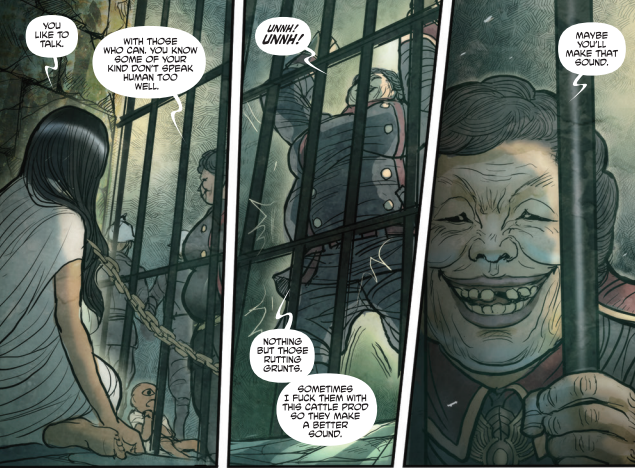
If I had one criticism about the book overall, it’s that it might not be for people unwilling to stick with the slow burn Liu has crafted. At a whopping 66 pages of gorgeous content though, it’s a minor complaint for such an exquisite read.
At the end of the day, this is a comic worth purchasing and adding to your collection, but please note, this is a comic aimed at mature readers for some graphic content!


